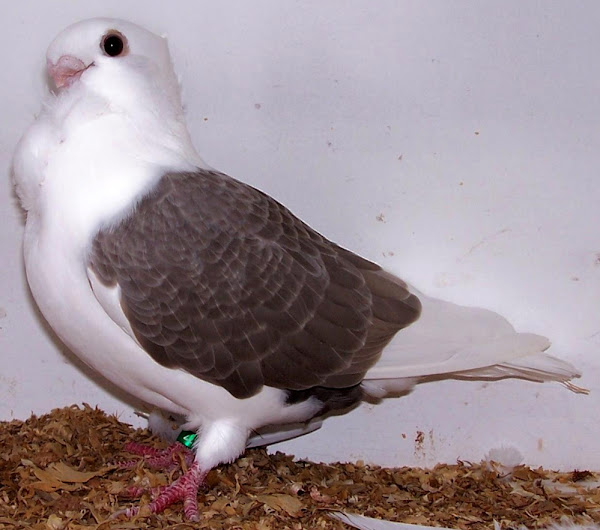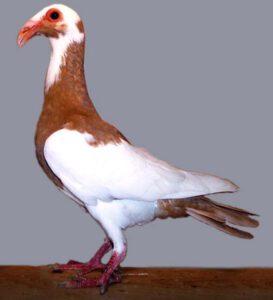The Turbit pigeon is a breed of domestic fancy pigeon from United Kingdom. It is also known by some other names such as Cravate Turbit, Turbitmövchen and Turbito.
The name, in relation to the bird’s shape, is derived from “turbo”, a Latin word meaning “spinning top”. Exact time of it’s creation is unknown, but probably it was developed in the seventeenth or eighteenth century.
It was actually developed over many years of selective breeding. It is believed that, the breed is the result of cross-mating of various Anatolian Owl with Show Antwerp.
The Turbit pigeon along with other domesticated pigeon breeds, all are descendants from the rock pigeon.
The Turbit pigeon is one of the breeds that Charles Darwin performed his experiments on. Read more information about the breed below.
Origin And History Of Turbit Pigeon
The Turbit pigeon breed originated from England and has a rich history dating back several centuries. It is an ornamental breed and was developed through selective breeding from early varieties of frillback pigeons. The Turbit breed was first recognized and standardized a s distinctive breed in the late 18th and early 19th centuries.
Characteristics
Turbit pigeon is a medium sized bird with compact body. It illustrates an erect and graceful carriage. These birds are easily distinguished for their short beak, peaked crest and frilled feathers on the neck.
Their body is usually of white color with colored wings. They have relatively large head compared to their body. And their body is wide at the skull with a good frontal.
Their neck is broad and slightly arched, and the eyes are large and prominent with fine white ceres. Their legs are of medium size and are red in color.
There are many color varieties of the Turbit pigeon. Common color combinations of these birds are black, blue, dun, red, silver, yellow, mealy and cream.
Average mature body weight of the Turbit pigeon is between 227 and 285 kg. Photo and info from PigeonSpot and Wikipedia.

Housing Requirements
Like many other domestic pigeon breeds, the Turbit pigeon also require a good housing system that ensures both comfort and safety. Ensure that your pigeon house is spacious enough, well-ventilated and well protected from extreme weather conditions for maintaining a stable and moderate temperature.
Provide enough perches and nesting boxes for roosting and breeding depending upon the number of your birds. Always try to clean the house on a regular basis. And also ensure that the house is secure enough to protect the birds from the predators.
Dietary Requirements
Like many other domestic poultry birds, the Turbit pigeons also require healthy and nutritious diet to stay active and healthy. So, always try to provide your birds with very good quality and nutritious food. Like most other pigeon breeds, the Turbit pigeons also love to eat a mix of grains, seeds and pellets.
It is also very important to provide your birds grit. Because grit helps the birds to ensure good digestion by breaking down the food in their stomachs. And along with providing your birds with good quality and nutritious food, always try to provide your birds with enough fresh and clean drinking water.
Reproduction/Breeding
The Turbit pigeons are naturally excellent breeders, like most other domestic pigeon breeds. And their breeding/reproduction management is very easy and simple. Just choose good quality, healthy and active Turbit pairs and arrange a good house for them, and they will do the rest.
Generally, both male and female Turbit pigeons take the responsibility to build the nest together. Then after successful mating, the female typically lay two eggs. And both male and female take responsibility of the incubation process of about 18 days. And both birds used to feed their babies until they are big enough to eat by themselves.
Behavior/Temperament
Like many other domestic pigeon breeds, the Turbit pigeons are also known for their gentle and friendly temperament (that’s why it’s a popular choice among the pigeon fanciers). They are relatively easy to handle and can adapt well to human interaction.
Caring
Taking good care of these birds is very important to keep them healthy, strong and active. The Turbit pigeons are relatively strong and hardy birds. They are also adaptive birds, and they generally can thrive themselves in various environments if you take good care of them.
Although, caring these birds is relatively easy and simple. And their caring process generally involves providing them a clean and safe home, balanced and nutritious food, and performing regular health check-ups.
Ensure good ventilation system inside their house and always try to clean their house on a regular basis. Ensure that their house is spacious enough depending on the number of birds you have.
Always provide your birds with enough good quality and nutritious food (preferably a mix of grains, seeds and pellets). Preform regular health checkups and always check your birds for any signs of diseases or illness. And always vaccinate your birds timely. Call a vet as soon as possible if you notice anything uncommon.
Uses
This is a breed of fancy pigeon. It is used for plying and ornamental/show purposes.
Popularity And Price
The Turbit pigeon is pretty popular among the pigeon enthusiasts and breeders. The breed is popular mainly for it’s frilled chest feathers and amiable temperament. It’s a ornamental breed and is frequently showcased in pigeon exhibitions and competitions.
It’s very tough for us to tell it’s exact price. Because it’s exact price depends on numerous factors (such as lineage, quality, age etc.) and can vary from place to place. Please visit any of nearest breeders to know more about it’s availability and price.
Lifespan
Average lifespan of the Turbit pigeon is between 10 and 15 years. But they can live even longer if you can take good care of them.
Pros And Cons
Like many other domestic pigeon breeds, the Turbit pigeons have some advantages and disadvantages. Here we are trying to list the pros and cons of Turbit pigeons.
Pros:
- Unique but beautiful appearance
- Friendly behavior
- Gentle temperature
- Popular show breed
- Can adapt themselves to a wide variety of climatic conditions
- Long lifespan
Cons:
- Sometimes require specialized care
- Susceptibility to disease
- Space requirements
- Costs relatively higher than many other common breeds
- Availability of the breed is limited
Special Notes
The Turbit pigeon breed is known for it’s short beak, peaked crest and frill of feathers on it’s breast. It is a popular breed of fancy pigeon in many countries in Europe. It has the ability to fly well.
The breed is good for ornamental purpose and also good for raising as pets. However, review full breed profile of this breed in the following chart.
| Breed Name | Turbit |
| Other Name | Cravate Turbit, Turbitmövchen, Turbito |
| Breed Purpose | Exhibition, flying, pets |
| Special Notes | Beautiful birds, excellent flyers, good for show, good for raising as pets, good for ornamental purpose |
| Breed Class | Medium |
| Weight | 227-285 grams |
| Climate Tolerance | Native climates |
| Flying Ability | Excellent |
| As Pets | Good |
| Color | Many, but common combinations of these birds are black, blue, dun, red, silver, yellow, mealy and cream |
| Rarity | Common |
| Country/Place of Origin | United Kingdom |
Frequently Asked Questions (FAQs)
Popularity of pigeon farming business is increasing gradually in many countries throughout the world. That’s why many people are trying to learn more about this business. Especially, the beginners ask us many questions about starting and operating a successful pigeon farming business. However, here we are trying to list the most common questions about Turbit pigeons and trying to answer them. Hope you will find your answer. Don’t hesitate to ask us if you have more questions.
Any Turbit pigeons for sale near me?
Actually it’s very tough for us to tell the exact answer. Please visit some of your nearest pigeon breeders to know for it’s availability in your area and also it’s price.
What do Turbit pigeons eat?
Like many other domestic pigeon breeds, the Turbit pigeons also love to eat a mix of grains, seeds and pellets.






